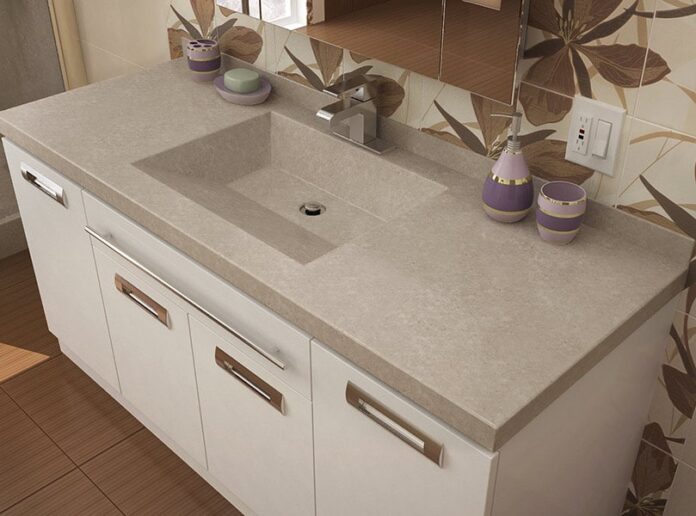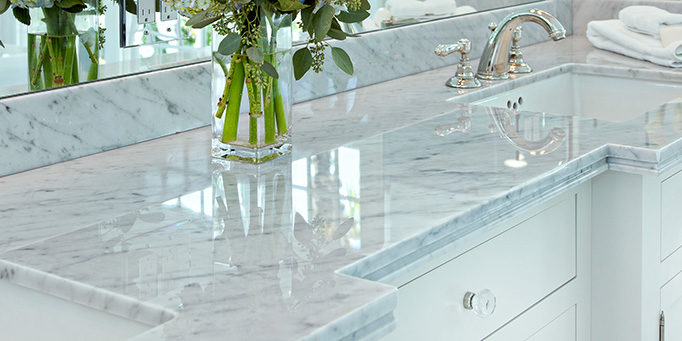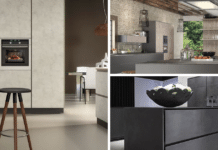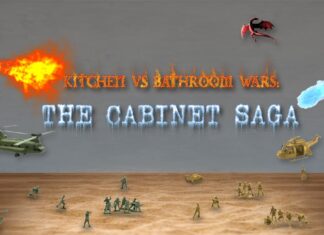A countertop is an essential surface in kitchens and bathroom vanity. Unlike table surfaces or other tops, counters are built to withstand moisture and messes, making them easier to clean.
We might lay a tablecloth on a dining room table or breakfast nook to deal with spills. However, we don’t think of doing this on countertops because they are created to handle many of these situations.
Different Types of Vanity Countertops
When shopping for kitchen or bathroom vanity countertops, we need something durable but nice to look at. However, among the different types of surfaces, it is challenging to distinguish which is best for our needs.
Marble Vanity Countertop
Marble is a material associated with luxury and elegance and reminiscent of works of art. Because of its status, telling someone you own a marble vanity countertop is also bragging rights.
The natural marble veining is one of the most distinct and classic textures and will last for many years.
However, it is the most expensive countertop, and even though it’s made of stone, it requires maintenance.
Marble is a porous rock, meaning the stain is difficult to remove if you spill anything on it.
Acidic fluids like wine, juice, and abrasive cleaners can ruin marble unless you immediately handle the stain.
So spilling a bit of pinot noir and then stopping the date to clean the spill quickly isn’t great for romance.
That’s a pretty expensive investment for something that has to be maintained regularly to keep the material looking pretty.
However, cultured marble is a good alternative for those who want the look but not the cost or lack of durability. Cultured marble is an engineered stone surface mixed with resin to increase its resistance to wear.
While it is an attractive option for kitchens or bathrooms, it’s not the most practical. Marble is resistant to heat but not food or liquid stains and needs sealing before use in either space.
Sealing will help prevent that damage, but with the porous, this requires constant upkeep.
- Pros: Beautiful and classic
- Cons: Costly and still requires maintenance
Ceramic Tile Countertop

Ceramic tile has a classic look on countertops and many possibilities. It is the most creative material, and people can build tiled countertops as DIY projects.
Tiles are the most inexpensive of all the materials and are available in various shapes and sizes.
If you are artistic, it’s a boon to express yourself on your countertop. Selecting the tiles, ensuring they fit, and cutting them to size is not difficult.
There are many sources of inspiration, especially with Spanish and Moroccan tiles, with several examples on Pinterest.
Several videos and sites explain how to grout ceramic tile, so there is no shortage of internet help.
However, it is important to be meticulous when choosing ceramic vanity countertops.
Imprecise measurements that start small can magnify later, but cutting the tile can fix that. Uneven grouting can also be very evident in tile countertops.
If a heavy impact occurs on one of the ceramic tiles, replacing that one section is typically not easy. It is not recommended to stand on a ceramic tile countertop surface; it’s not the same as ceramic floor tile.
Once established, the challenge in maintaining ceramic tile is keeping the grout between the tiles clean. However, cleaners with bleach are sufficient to handle this.
- Pros: Inexpensive and can be a DIY project
- Cons: Need to clean grout, cannot bear weight, and could break
Quartz Vanity Countertop
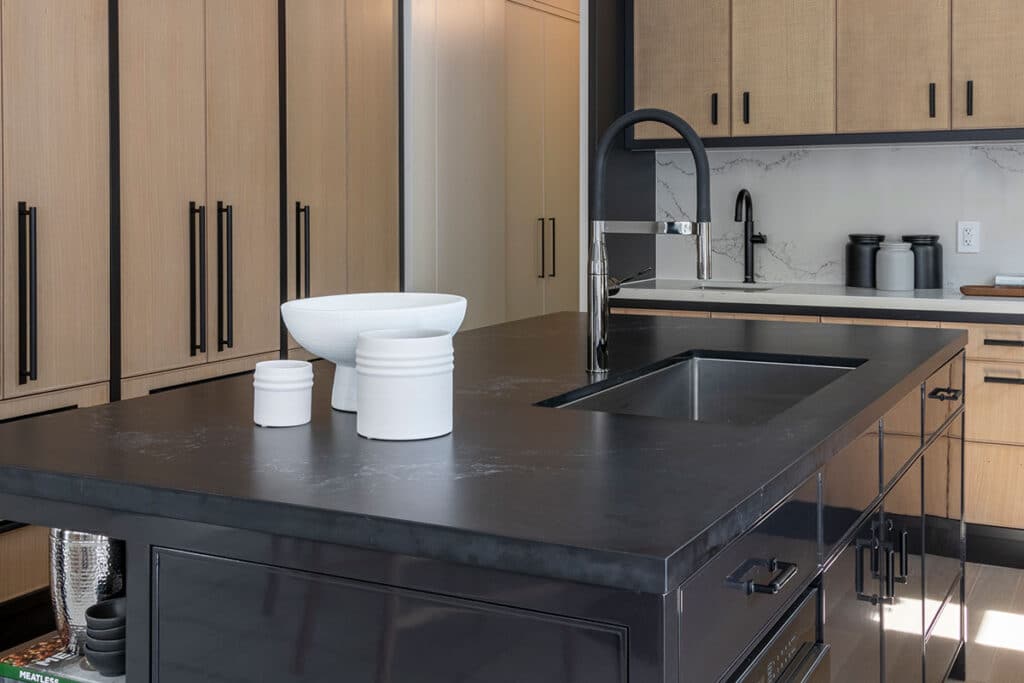
Quartz is also known as “Engineered Stone,” and it is actually quartz stone reinforced with polymer resins to increase toughness.
More toughness means it is scratch-resistant and stain-proof, a huge plus for your bathroom vanity.
It is not porous like marble, so it is low maintenance, and soap and water are sufficient to clean the surface.
Because quartz or engineered stone withstands splatters and smudges, this is an excellent choice for households with children.
This countertop does not concern itself with the occasional kid’s drawing phase, where they happen to use markers on everything.
If you are always on the go and can’t dedicate much time to cleaning, quartz is also a choice. Products like shampoo, bleach, or anything else with chemicals will not be a significant concern if spilled on quartz.
Quartz comes in various designs that fit your taste in vanity countertops, from classic hues to bold choices. The surface selections can mimic other appearances like marble or granite.
For all these advantages, this tends to drive up the price of quality, especially for its durability. It is also a dense, heavy material if you feel like installing it yourself in the bathroom.
- Pros: It is one of the most stain-resistant surfaces for vanity countertops, and various designs are available.
- Cons: The benefits of the material drive up the cost
Solid Surface Countertop
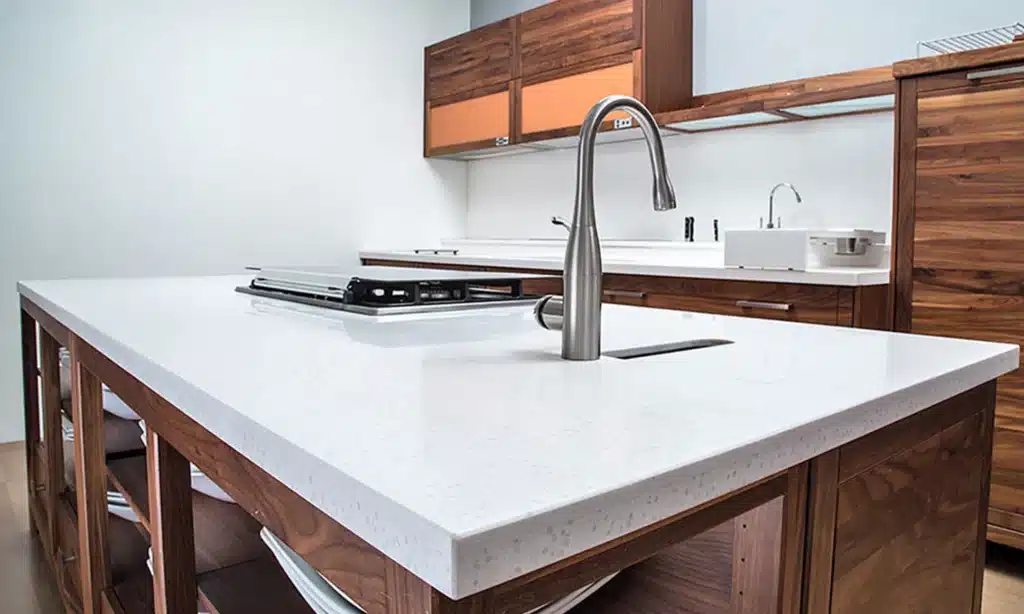
While you can argue that EVERY countertop is a solid surface, this refers to acrylic with resin countertops. For those who were curious, the opposite of a “solid surface” is a “porous surface” with materials such as marble and soapstone.
The composition of this synthetic material makes it impervious to bacteria and mildew, so it is innately hygienic. It is perfect when you shower and drip water everywhere on your vanity after a gym workout.
Solid surfaces come in various colors; some can mimic the appearance of luxurious materials but not the texture. Integrated countertop sinks are available in this material for that seamless vanity and sink look.
The surface is also scratch-resistant but cannot withstand high temperatures. While this is not ideal for a kitchen, it is less of a concern in a bathroom.
Some personal appliances, like heaters and curling irons, may damage your surface. However, this damage can be fixed by sanding, making it easy to repair.
Due to the particulars of this surface, this is not a DIY project. You will need professionals to install a solid surface countertop on your bathroom vanity.
- Pros: Resistant to bacteria and can come as an integrated sink
- Cons: Does not handle high heat well
Granite Vanity Countertop
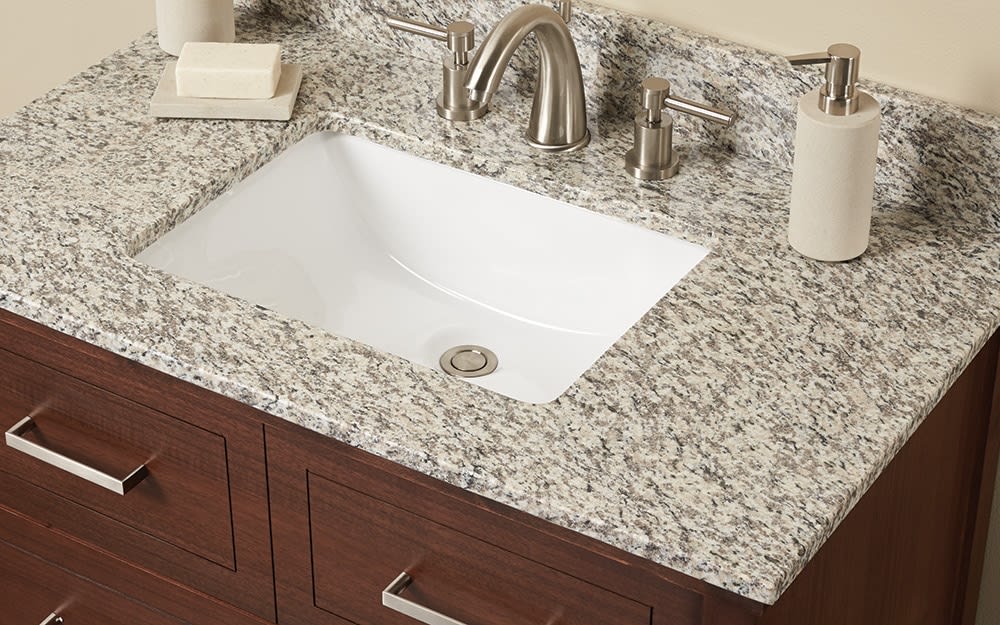
Granite is a durable natural stone that is considered a luxurious surface for a bathroom vanity. Its unique texture makes it popular for any countertop.
The color is limited to what naturally occurs in the granite mined from the quarry. However, since the appeal is the natural stone occurring art in the stonework, anything else would not feel right.
Granite countertop patterns are striking; they can look like the stones of a riverbed or even like frozen lava. The slabs may naturally have flaws, but that is part of the charm.
Granite can sustain heat and is impervious to water, making it a great kitchen surface. Yet the surface is so hard that you must purchase more than you need.
Just like sculpting, a professional installer needs to cut it down to the proper countertop size. Because of the granite pattern, it’s difficult to cut to pieces and align seams, so it’s usually one big piece.
Granite is on the pricey side of countertops, but the look and durability may be well worth it to some homeowners.
- Pros: Hard surface that can handle most situations
- Cons: Expensive and hard to install
Laminate Countertop

Some of the most affordable and standard vanity countertops on the market are laminate.
This surface is created from pressurized plastic and can duplicate the appearance of other, more expensive materials. It is also among the easiest to maintain.
Laminate is the thinnest countertop surface and a similar material when discussing “laminating” paper.
However, using a paper laminator for your counter will not have the same effect without pressured layers to harden it. It also needs an MDF (Medium-density fibreboard) or particleboard to strengthen the core.
Since both these materials are cheap to fabricate, it is an economical option for most people.
These synthetic exteriors are easier to clean than other countertops.
While laminate is water and stain-resistant, it can take damage from heat, which warps or dulls the surface. If this happens long enough, the laminate will become damaged and irreparable.
While laminate is inexpensive, the cost increases for more durable and fashionable versions. The fact that it can be made of recycled materials makes this option environmentally sustainable.
- Pros: Inexpensive with a large variety of looks, easy to maintain
- Cons: While easy to clean, subject to warping and heat damage

